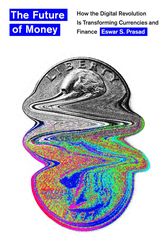In the seventh century, precious metals—the traditional commodity of exchange—started becoming too unwieldy as trade relations opened up between far-flung places. The first paper money was certificates of deposits issued by personalities of repute and backed up by metals or commodities. Paper currency not backed by commodities was first issued by Kublai Khan of the Yuan dynasty in China. Now, China (and countries like Sweden) is leading the race to eliminate paper currency as a whole; digital currencies issued by central banks (CBDCs) are slowly taking root worldwide.
In his book, The Future of Money: How the Digital Revolution Is Transforming Currencies and Finance, Professor Eswar Prasad argues that this historical symmetry is the indication of an impending massive disruption that will affect households, corporations and governments. Prasad is Tolani Senior Professor of Trade Policy at Cornell University.
In his book, he identifies the genesis of cryptocurrency Bitcoin, the decentralised payment system, in 2009 as the herald of a significant “fintech” revolution “touching all aspects of finance”. However, Prasad is not too “bullish” on the prospects of the Bitcoin—which he states has completely failed in its original intent payment network—but believes the “truly ingenious” underlying technology is here to stay.
Fiat (sovereign) currencies, for the first time in a generation, are facing tight competition in its almost complete dominance as a medium of exchange and store of value. So are its issuers. With decentralised payment mechanisms now open to all, transactions are settled quicker and more efficiently, at lower costs.
The cryptocurrency playbook is now being co-opted across the world. Facebook has come out with its own stablecoin, Diem (rebranded from Libra), with an aim to make international transactions simpler. Amazon has come out with Amazon Coins that can be used across its verticals.
Sovereign nations are in a race to develop CBDCs. However, on the flip side, Prasad identifies a lot of looming dangers. What if, because of network effects, one player or a couple of players gain absolute dominance in the field? What if consumers lost confidence in private payment systems during periods of financial stress? When traditional financial institutions like banks are facing big threats to their very existence, what are the complications for global financial stability, given the major role they play in credit creation?
What if Amazon and Facebook, with massive customer bases and the financial clout to provide stability, chip away at central bank money as a medium of exchange and store of value, reducing its ability to regulate economy and inflation properly? Are CBDCs in itself a good idea, given the threat of surveillance and issues like privacy?
The author looks at all these questions and more in an eminently readable work that is accessible and smooth. From banks to cryptocurrencies to fintech, he gives a detailed crash course on the present and lays out breadcrumbs to an uncertain future. As Prasad says, only one thing is for sure, cash is on its way out. What the future holds remains to be seen.
The Future of Money: How the Digital Revolution Is Transforming Currencies and Finance
By Eswar S. Prasad
Published by Belknap Press
Price Rs799; pages 446



